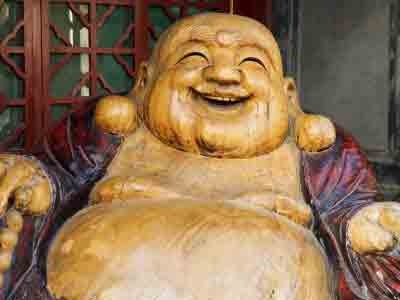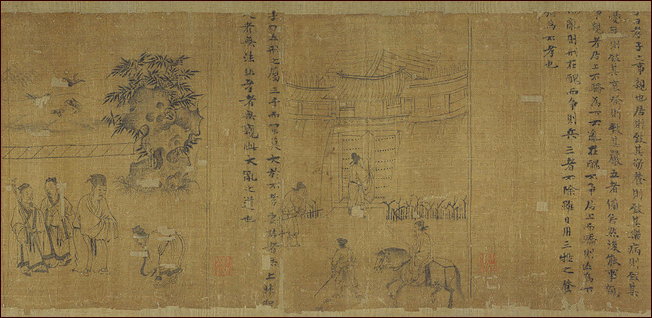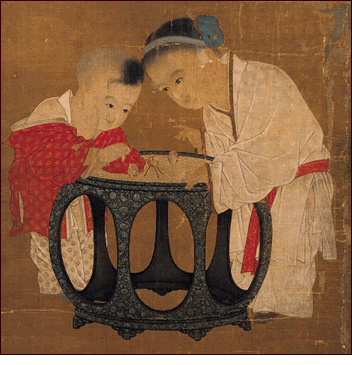Neo-Confucianism and Buddhism: How They Spread and Their Affect
Sarah Babbie
The Spread of Buddhism and the Influence on Art, Literature, and Culture.
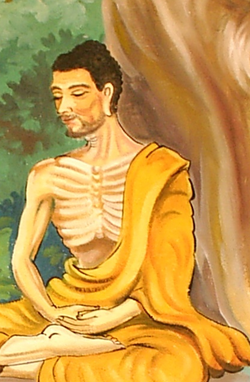
The Buddha while meditating.
This section has been about cultural interactions, so the examples that seem to show the strongest are those in Neo-Confucianism and Buddhism. Because Neo-Confucianism is the result of the spread of Buddhism, it will be discussed later on in this page.
Buddhism started off in India with a prince named Siddhartha Gautama, after he saw the sufferings other people had. The basic story is, Siddhartha was a prince who one day traveled outside of his sheltered life and looked around. While out, he saw the suffering other people had and decided to meditate on this idea. When he emerged he was enlightened and told people of his thoughts on how to stop the suffering people have. People in India quickly picked it up because Buddhism does not have a built in caste system.
It traveled along trade routes into China with many other ideas around 202 AD, but this one also caught fire in that area. In an edict from Emperor Wu Zong he says, "[Buddhism] has spread to the hills and plains of all the nine provinces and through the walls and towers of our two capitals. Each day finds its monks and followers growing more numerous and its temples more lofty."
At the same time it was accepted by the commoners, it was rejected by the Confucian leaders. This idea came from the immense amounts of spirituality that Buddhism has, especially with their beliefs in rebirth. This led to Neo-Confucianism.
In terms of what Buddhism did to art, they brought a focus back more toward nature, but not as much as Taoism did. A lot of elements in Chinese art were added to typical Buddhist art, such as the styling of having thin eyes and a small neck compared to the head. However, the real impact was made in the addition of statues to Chinese culture again. An example of a statue can be seen below. Another example of Southeastern Asian influence on Buddhist art is the Budai or Fat Buddha. He is supposed to represent the idea of being happy without having much, hence why he is wearing a cloth sack. Many Americans see this image and think of the actual Buddha, which really speaks to the influence it's had in the world. Budai is a character from Chinese and Korean folklore who represents a content Buddhist monk. The Budai is represented in a lot of Chinese art today.
Buddhism started off in India with a prince named Siddhartha Gautama, after he saw the sufferings other people had. The basic story is, Siddhartha was a prince who one day traveled outside of his sheltered life and looked around. While out, he saw the suffering other people had and decided to meditate on this idea. When he emerged he was enlightened and told people of his thoughts on how to stop the suffering people have. People in India quickly picked it up because Buddhism does not have a built in caste system.
It traveled along trade routes into China with many other ideas around 202 AD, but this one also caught fire in that area. In an edict from Emperor Wu Zong he says, "[Buddhism] has spread to the hills and plains of all the nine provinces and through the walls and towers of our two capitals. Each day finds its monks and followers growing more numerous and its temples more lofty."
At the same time it was accepted by the commoners, it was rejected by the Confucian leaders. This idea came from the immense amounts of spirituality that Buddhism has, especially with their beliefs in rebirth. This led to Neo-Confucianism.
In terms of what Buddhism did to art, they brought a focus back more toward nature, but not as much as Taoism did. A lot of elements in Chinese art were added to typical Buddhist art, such as the styling of having thin eyes and a small neck compared to the head. However, the real impact was made in the addition of statues to Chinese culture again. An example of a statue can be seen below. Another example of Southeastern Asian influence on Buddhist art is the Budai or Fat Buddha. He is supposed to represent the idea of being happy without having much, hence why he is wearing a cloth sack. Many Americans see this image and think of the actual Buddha, which really speaks to the influence it's had in the world. Budai is a character from Chinese and Korean folklore who represents a content Buddhist monk. The Budai is represented in a lot of Chinese art today.
|
In South East Asian literature, Buddhism also had a large indirect influence. Buddhism led to an increase in peace generally, because of the peace people had more free time. More free time means more time to grow as a person in terms of intelligence and fun levels. Meaning, Buddhism led to higher levels of education. This means more people would learn how to read and write. This is why Chinese writings don't really pick up until after Buddhism comes to the nation.
Also, many monks traveled around and learned of other countries and the issues that would bother them. This means the monks would become more educated while on their journeys. So, the monks can tell people of what they know or get a book published about other places, which adds to the literature. (Kind of a Marco Polo situation, but with Monks.) For Buddhism's effect on Cultural Traditions, the best way to represent the impact would be with a number. 100 million. That is the number of practicing Buddhists in China today. Most people think of China when they think of Buddhism. The culture was at one point a place known for it's powerful military force, but when people imagine that time period, they see Buddhist temples and peaceful images that would come from Taoist renderings of nature. People wanted to live simpler lives and to end suffering. The people who didn't believe in spiritual ideas before converted to a religion much different from the one they originally practiced. |
The Beginning of Neo-Confucianism
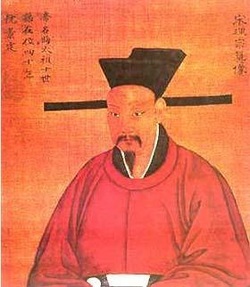
Zhou Dunyi
Neo-Confucianism is the direct result of the interactions between Buddhism, Taoism, and Confucianism. The people who deeply believed in Confucius ideals looked down upon the new religions and their mysticism. An example of this can be seen in a document from Han Yu which reads:
"Your Majesty has ordered the community of monks to go to Fengxiang to greet the bone of Buddha, that Your Majesty will ascend a tower to watch as it is brought into the palace, and that the various temples have been commanded to welcome and worship it in turn. Though your servant is abundantly ignorant, he understands that Your Majesty is not so misled by Buddhism as to honor it thus in hopes of receiving some blessing or reward, but only that, the year being one of plenty and the people joyful, Your Majesty would accord with the hearts of the multitude in setting forth for the officials and citizens of the capital some curious show and toy for their amusement. … But the common people are ignorant and dull, easily misled and hard to enlighten, and should they see their emperor do these things they might say that Your Majesty was serving Buddhism with a true heart. “The Son of Heaven is a Great Sage,” they would cry, “and yet he reverences and believes with all his heart! How should we, the common people, then begrudge our bodies and our lives?” Then would they set about singeing their heads and scorching their fingers, binding together in groups of ten and a hundred, doffing their common clothes and scattering their money, from morning to evening urging each other on lest one be slow, until old and young alike had abandoned their occupations to follow [Buddhism]. … Then will our old ways be corrupted, our customs violated, and the tale will spread to make us the mockery of the world. This is no trifling matter!"
The significance of this is showing how much the people were against the mysticism.
Zhou Dunyi, a philosopher from the Song Dynasty who realized that Confucianism really had no ideas for what would happen after people died. So, he added principles from Taoism and Buddhism into Confucianism so ideas from all three were maintained. This was rather revolutionary for a lot of people who were used to their old traditions, but this came out when Confucianism was dying out a bit, which made it much simpler than it could have been.
"Your Majesty has ordered the community of monks to go to Fengxiang to greet the bone of Buddha, that Your Majesty will ascend a tower to watch as it is brought into the palace, and that the various temples have been commanded to welcome and worship it in turn. Though your servant is abundantly ignorant, he understands that Your Majesty is not so misled by Buddhism as to honor it thus in hopes of receiving some blessing or reward, but only that, the year being one of plenty and the people joyful, Your Majesty would accord with the hearts of the multitude in setting forth for the officials and citizens of the capital some curious show and toy for their amusement. … But the common people are ignorant and dull, easily misled and hard to enlighten, and should they see their emperor do these things they might say that Your Majesty was serving Buddhism with a true heart. “The Son of Heaven is a Great Sage,” they would cry, “and yet he reverences and believes with all his heart! How should we, the common people, then begrudge our bodies and our lives?” Then would they set about singeing their heads and scorching their fingers, binding together in groups of ten and a hundred, doffing their common clothes and scattering their money, from morning to evening urging each other on lest one be slow, until old and young alike had abandoned their occupations to follow [Buddhism]. … Then will our old ways be corrupted, our customs violated, and the tale will spread to make us the mockery of the world. This is no trifling matter!"
The significance of this is showing how much the people were against the mysticism.
Zhou Dunyi, a philosopher from the Song Dynasty who realized that Confucianism really had no ideas for what would happen after people died. So, he added principles from Taoism and Buddhism into Confucianism so ideas from all three were maintained. This was rather revolutionary for a lot of people who were used to their old traditions, but this came out when Confucianism was dying out a bit, which made it much simpler than it could have been.
|
In terms of Neo-Confucianism's affect on art, it stressed Nature again and it's want to be represented as it is, this concept is called Li. "We could say, too, that clouds have li, marble has li, the human body has li. We all recognize it, and the artist copies it whether he is a landscape painter, a portrait painter, an abstract painter, or a non-objective painter. They all are trying to express the essence of li", a quote from Alan Watts.
To the right is what can be described as a lesson scroll. It teaches people with text and pictures. The pictures are drawn from nature with the idea of being accurate in them. It's basically the art that was already going on at the time but with more reasons, because it fused three religions. Another common thing seen in the artwork are pictures of families, particularly women and children doing what they were supposed to do. The women were typically doing housework such as cleaning the children, whereas the children would be seen playing. There are also a great number of scrolls showing children gathered around a toy seller. This shows that children being happy was a big part of this religion. |
|
In terms of literature, the result was much the same as Buddhism where it increased literacy and thus the level of literature. Some examples of the literature seen were rather similar to Confucianism, though, because it taught life lessons such as respecting ones elders and how to be good in life. This usually meant through work.
The cultural impact was large, because it was an even ground to stand on. It incorporated a lot of ideas to Chinese culture, and was more readily accepted than Buddhism. A lot of people accepted it and it brought a revival in Confucian beliefs when they were dying out more. Neo-Confucianism also brought the focus of people in China back to families. The children were expected to become educated in this religion, but the children also got to have fun. The idea of respecting many generations of people is a very Confucius idea, this was revived because of the fusion of cultures that comes from interactions. |
Sources
http://afe.easia.columbia.edu/song/sch/confuc.htm
http://www.onelittleangel.com/wisdom/quotes/neo_confucianism.asp
http://afe.easia.columbia.edu/tps/1000ce.htm#neoconf
http://www.csuchico.edu/~cheinz/syllabi/asst001/fall97/7merc.htm
http://en.wikipedia.org/wiki/Chinese_literature
http://academic.brooklyn.cuny.edu/core9/phalsall/texts/chinlit.html
http://library.thinkquest.org/28131/5influen.htm
http://en.wikipedia.org/wiki/Buddhism_by_country
http://afe.easia.columbia.edu/song/sch/confuc.htm
http://www.onelittleangel.com/wisdom/quotes/neo_confucianism.asp
http://afe.easia.columbia.edu/tps/1000ce.htm#neoconf
http://www.csuchico.edu/~cheinz/syllabi/asst001/fall97/7merc.htm
http://en.wikipedia.org/wiki/Chinese_literature
http://academic.brooklyn.cuny.edu/core9/phalsall/texts/chinlit.html
http://library.thinkquest.org/28131/5influen.htm
http://en.wikipedia.org/wiki/Buddhism_by_country
